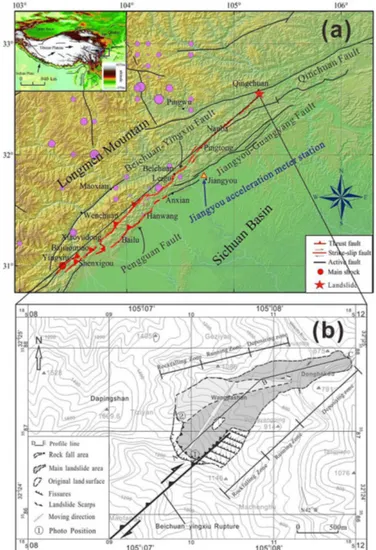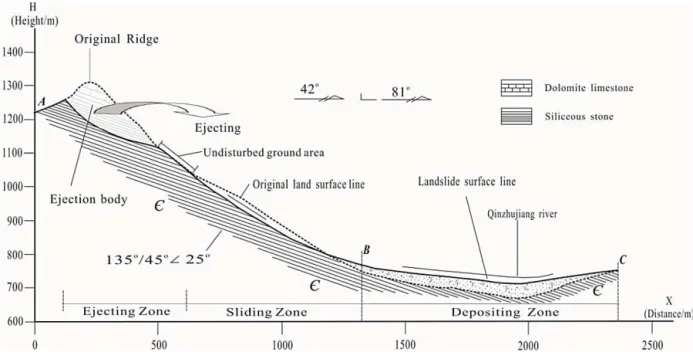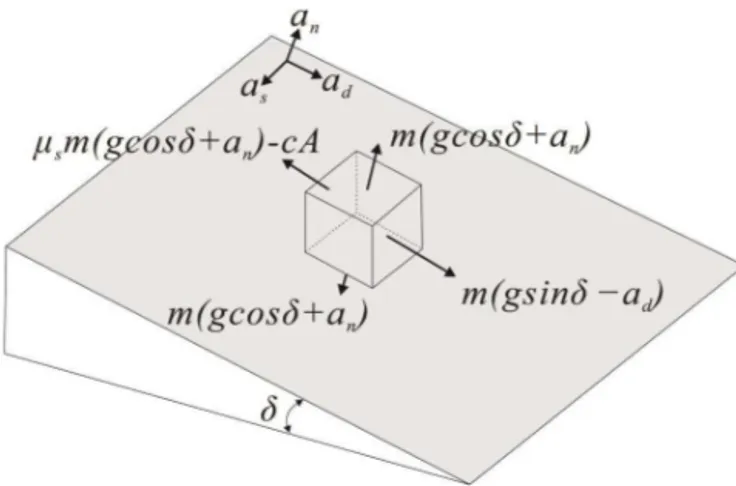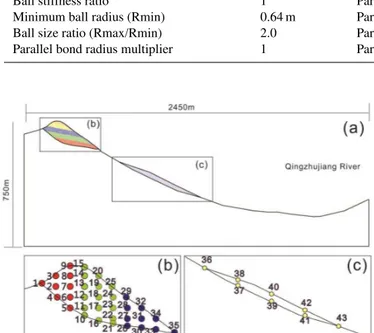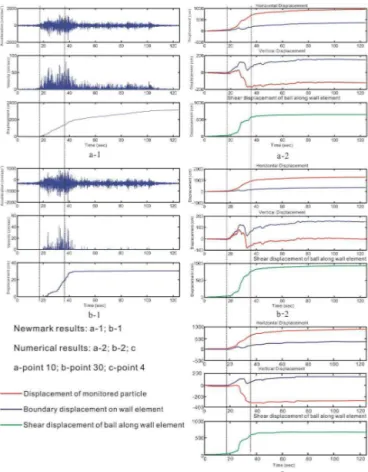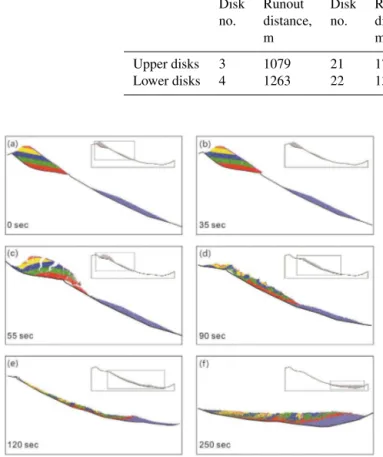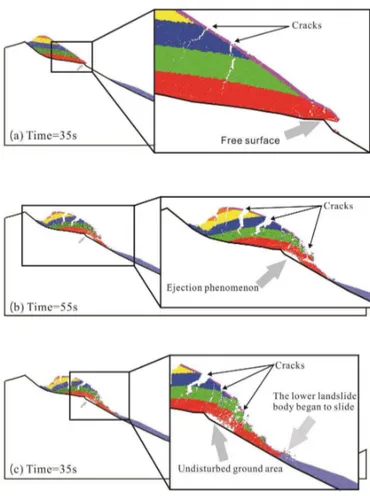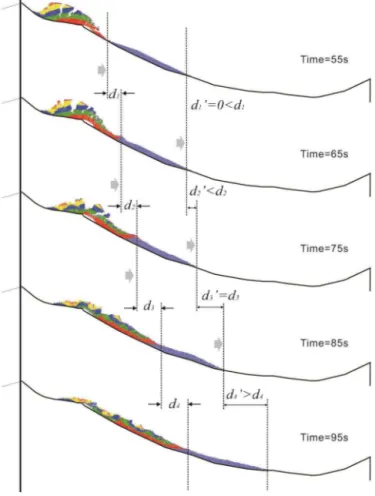www.nat-hazards-earth-syst-sci.net/14/1195/2014/ doi:10.5194/nhess-14-1195-2014
© Author(s) 2014. CC Attribution 3.0 License.
Mechanism of the Donghekou landslide triggered by the 2008
Wenchuan earthquake revealed by discrete element modeling
R.-M. Yuan1,2, C.-L. Tang3, J.-C. Hu3, and X.-W. Xu1
1Key Laboratory of Active Tectonics and Volcano, China Earthquake Administration, Beijing 100029, China 2Institute of Geology, China Earthquake Administration, Beijing 100029, China
3Department of Geosciences, National Taiwan University, Taipei 10617, Taiwan Correspondence to:J.-C. Hu (jchu@ntu.edu.tw)
Received: 24 August 2013 – Published in Nat. Hazards Earth Syst. Sci. Discuss.: 23 December 2013 Revised: 5 March 2014 – Accepted: 27 March 2014 – Published: 21 May 2014
Abstract. The huge Donghekou landslide was triggered by the Wenchuan earthquake in 2008 with about 2.4×107m3 of rock displaced. The landslide is considered as an exam-ple of an earthquake-induced “ejection” event, where dis-located slope materials was expelled over a section of the slope, but the kinematic processes are not well understood. We used the 2-D granular discrete element method to char-acterize the kinematic behavior and mechanics of this “ejec-tion landslide”. The initial boundary condi“ejec-tions were applied along the ball–wall contacts by using derived velocities inte-grated from strong motion data with a duration of 125 s, in-cluding the peak acceleration near the Donghekou area. The constraints were primarily determined from the final geom-etry of the landslide and geological structures to account for the actual landslide characteristics. Simulated results showed that the large local seismic acceleration and a free face un-der the sliding body, caused by the dip difference between the upper slide face and the natural slope, originated from the activation of the landslide. For the lower sliding body, its kinematic mechanism was changed during sliding. Initially it was a push-type landslide, and then gradually changed to a retrogressive landslide. The eroded bed on the slope dur-ing the landslide had the potential of slightly increasdur-ing the runout distance from 1435 to 1519 m, and was predicted in the numerical simulation.
1 Introduction
Earthquakes cause large-scale ground movement (shaking) and can trigger severe landslides over broad areas resulting in serious damage and casualties (Harp and Jibson., 1996; Central Geological Survey, 2000; Chigira et al., 2003; Keefer et al., 2006; Keefer and Larsen, 2007; Dai et al., 2010). To analyze an earthquake-induced landslide hazard, in addition to describing the regional correlation between seismic events and landslides under various conditions, it is critical to study the failure mechanism of catastrophic earthquake-induced landslides. However, the assessment of catastrophic land-slides requires knowledge of landslide characteristics and runout mechanics.
many researchers have adopted discrete element methods to analyze landslides (Campbell et al., 1995; Poisel and Roth 2004; Poisel et al., 2005; Staron, 2007; Peng, 2008; Tang et al., 2009a, b, 2013). This research validated numerical mod-eling based on discrete element methods, which is a powerful tool for modeling rock slope failure due to seismic shaking.
After the Donghekou landslide triggered by the 2008 Wenchuan earthquake, several field investigations were car-ried out for landslide mapping and to define trigger mech-anisms (Yin, 2008, 2009; Yin et al., 2009, 2011; Sun et al., 2009a, b; Wang et al., 2009; Tang et al., 2010; Yuan et al., 2010, 2013; Zhang et al., 2011; Huang and Fan, 2013). Meanwhile, numerical simulations based on various investi-gations were also applied to analyze the movement processes (Li et al., 2012; Zhang et al., 2012). However, the kinematic processes controlling the moving mass and the mechanism for some special phenomena associated with this huge land-slide are still poorly understood because of the complicated movement processes and unique type.
In this paper, we try to address some special phenomena of the Donghekou landslide using the 2-D discrete element method for granular materials, which is helpful for charac-terizing the complex kinematics and triggering process of a large landslide. We focus especially on explaining the ejec-tion of the upper landslide body and the formaejec-tion of two disconnected landslide surfaces.
2 The Donghekou landslide
On 12 May 2008, the Mw=7.9 Wenchuan earthquake struck the Longmenshan area, Sichuan Province, China, along the middle segment of the Longmenshan thrust belt, at the east-ern margin of the Tibetan Plateau (Fig. 1a). Field investiga-tions showed that the co-seismic surface rupture zones along the Beichuan-Yingxiu Fault and the Pengguan Fault propa-gated unilaterally in a northeast direction for over 300 km, involving thrusting and right-lateral components (Xu et al., 2009).
The Wenchuan earthquake triggered thousands of mass movements in the Longmenshan area (Dai et al., 2010), where some huge landslides caused an extreme loss of life and property (Yin, 2008). Among these landslides, the Donghekou landslide was exceptional, located at the northeast end of the Beichuan Rupture (32.40572◦N, 105.11081◦E), and caused serious loss of life at the village of Donghekou, Qinchuan, Sichuan Province (Fig. 1a, b). It can be described as the combination of two effects: the pri-mary landslide and a significant rock fall. In this paper, only the primary landslide is simulated to better understand its for-mation mechanism.
The primary landslide, with an estimated volume of about 2.4×107m3, originated at an elevation ranging between 1150 and 1350 m; it traveled downhill towards the north-east for about 2.45 km, and ended at the confluence of the
Figure 1.Main shock of the Wenchuan earthquake: regional struc-tures(a), and outline of the Donghekou landslide(b).
Qingzhu and Hongshihe Rivers where two large lakes were formed. The vertical drop from the ridge to the rivers is ap-proximately 600 m (Figs. 1b and 2).
Figure 2.A geologic profile (A–B–C) of the Donghekou landslide (Yuan et al., 2010; profile shown in Fig. 1).
3 Geological setting of the Donghekou area
The Donghekou landslide is located in a mountainous re-gion at the northern termination of the Beichuan rupture zone (Fig. 1). The elevation of the Dapingshan Mountain, where the Donghekou landslide occurred, is 1609.6 m. Its slope is approximately uniform at 40◦, though portions of the moun-tain surface are as steep as 70◦–80◦. Such steep conditions are partly responsible for the occurrence of such a complex landslide.
The two main outcropping geological formations along the mountain slopes are dolomite limestone and siliceous phyllite. The dolomite limestone, with an orientation of 41◦ 6 26◦, was observed mostly in the rock fall area, on the northwest side of the ejection landslide, and only a few lime-stone outcrops were found at the top of the slope (Fig. 2). In contrast, the siliceous phyllite, with an orientation of 41◦ 6 26◦, was observed mainly in the area of the main land-slide and in the zone of the domino-like ground tension fis-sures.
4 The Newmark displacement method and two-dimensional distinct element modeling
The Newmark displacement method and a discrete granu-lar simulation technique were used in this paper to investi-gate the mechanics of the Donghekou landslide. The major methodological and technical aspects of the numerical simu-lation are summarized below.
4.1 Principles of the Newmark displacement method
In 1965, N. M. Newmark first proposed the basic elements of a procedure for evaluating potential deformations of an em-bankment dam due to earthquake shaking (Newmark, 1965). By computing the ground motion acceleration at which the inertial force becomes sufficiently high to cause yielding, as shown in Fig. 3, and integrating the acceleration exceeding the yield acceleration in the sliding mass, the ultimate dis-placement can be evaluated. Here the authors applied the Newmark displacement method to calculate the free-body force of the Donghekou landslide mass during the 2008 Wenchuan earthquake, assuming that the block slid when the peak acceleration was beyond the yield acceleration. The free-body diagram illustrates the situation of the sliding block before the earthquake (Fig. 3). Thus the force normal to the slope is mgcosδ, wheremis the mass of the free-body, gis the gravitational acceleration, andδ is the dip angle of the inclined surface. A basal friction force µsmgcosδ conse-quently balances themgsinδ downslope force generated by gravity, so that the stability condition can be written as
mgsinδ <µsmgcosδ+cA, (1)
whereµsis the coefficient of static friction,cis the cohesive strength along the sliding surface, andAis the area of the sliding surface.
We then introduced the safety factor, FS (Newmark, 1965; Wilson and Keefer, 1983), to evaluate the sliding threshold across an existing bedding plane:
FS= µsmgcosδ+cA
Figure 3. Diagram illustrating the critical balance condition of forces exerted on a rock block lying on an inclined planar surface under the earthquake ground motion.
For the Donghekou landslide, because the initial slide di-rection almost coincided with the dip of the underlying surface, the initial movement was inferred to be a nearly pure translation. We adopted the cohesion of intact shale of 1.65×104N m−2(Sun et al., 2009a), a density of 2.6 g cm−3 and a dipδ=25◦. The calculated FS was greater than 1. We inferred that sliding over an existing bedding plane is only possible if other external triggering mechanisms are present (such as an earthquake or rainfall), or if the down-dip accel-erationadis beyond the yield acceleration.
To calculate the down-dip sliding acceleration, S, the data obtained from the nearest station measuring PGA (peak ground acceleration), situated in the Jiangyou valley at (31.8◦N, 104.7◦E), was used to analyze the PGA values in the Donghekou area:
S=(gsinδ−ad)−µs(gcosδ+an)−cA/m, (3) whereadandanrefer to the down-dip and normal-to-sliding components of acceleration, respectively.
4.2 Distinct element modeling
The technique of distinct element modeling (DEM) was first developed to simulate rock-block systems (Cundall, 1971); it was later applied to the modeling of granular material (Cun-dall and Strack 1979). DEM is currently widely used in re-search related to rock mechanics and brittle tectonics (e.g., Hu and Angelier, 2004; Egholm, 2007; Egholm et al., 2007; Yang et al., 2014). The main calculation uses a time-explicit method and is capable of bonding particles into a mass by bonds. Particle Flow Code (PFC) models are made up of discrete particles, allowing for individual movements. The points where particles touch each other are called contacts. The numerical modeling technique that we adopted for the experiments reported here involved a particular application, PFC2D, of the 2-D particle flow code (Itasca, 2002). This
technique is commonly used for modeling granular assem-blages with purely frictional or bonded circular particles rep-resented by discs and is now widely used to resolve rock engineering and geomechanics problems (e.g., Wang et al., 2003; Potyondy and Cundall, 2004; Tang et al., 2009a, b, 2013, 2014).
4.2.1 Microproperties
All numerical simulations by PFC modeling require proper selection of microparameters by means of calibration pro-cesses in which the response of the numerical modeling is compared with the observed results of the physical material. Attempts to improve and simplify the calibration process and modeling procedure have been reported in the literature (e.g., Itasca, 2002; Potyondy and Cundall, 2004). More recently, the application of experimental design and optimization in uniaxial compression simulations was proposed to calculate proper microparameters for model generation in PFC (Yoon, 2007). For a bond model, the overall mechanical behaviors of the assembly of particles are controlled by microproperties such as normal and shear stiffness, normal and shear bonds, and the Coulomb friction coefficient. There is no straight-forward solution with regard to microproperties and macro-properties, but a relationship exists between the two scales of properties for an initial calibration.
Young’s modulus of the material is linearly related to the value of contact stiffness. Parallel bonds increase contact stiffness (Itasca, 2002). Young’s moduli of the grains (Ec) and cement (Ec) are expressed by
Ec=
( k
n
2t , PFC2D Disk mode kn
4R , PFC3D, PFC2D Sphere model
(4)
Ec=kP
R(A)+R(E), (5)
wherekn,Kp,R andt are normal particle stiffness, paral-lel bond normal stiffness, particle radius and disk thickness, respectively (Potyondy and Cundall, 2004). Thus, Poisson’s ratio depends both on the ratio of shear contact stiffness to normal contact stiffness and packing geometry. The peak strength of the material depends both upon the friction co-efficient and the bond strength (Itasca, 2002).
Table 1.Microproperties and macroproperties of models based on a series of biaxial tests.
Parameters of the packing of disks
Disk density 2650 (kg m−3) Parallel bond modulus (on slope) 50 MPa
Disk thickness 2 (m) Ball friction coefficient 0.5
Ball–ball contact modulus (landslide block) 5.0 GPa Parallel bond normal strength parallel to strata (landslide block) 50 MPa
Ball–ball contact modulus (on slope) 50 MPa Parallel bond normal strength non-parallel to strata (landslide block) 10 MPa
Ball stiffness ratio 1 Parallel bond shear strength parallel to strata (landslide block) 50 MPa
Minimum ball radius (Rmin) 0.64 m Parallel bond shear strength non-parallel to strata (landslide block) 10 MPa
Ball size ratio (Rmax/Rmin) 2.0 Parallel bond normal strength (on slope) 1 MPa
Parallel bond radius multiplier 1 Parallel bond shear strength (on slope) 1 MPa
Figure 4. Numerical model of the Donghekou landslide and the monitoring disks within the sliding blocks.
4.2.2 Numerical model for the Donghekou landslide
The dimensions employed in the Donghekou landslide model were 2450 m (length) and 750 m (height) (Fig. 2). A profile of the slope was first built to perform a numerical simula-tion. In the numerical model, the rocks under the sliding sur-face were represented by “wall elements”. Then, the particles composing the sliding mass were randomly generated inside the entire deforming region, including the upper sliding body and lower sliding mass (Fig. 4a). The different colors in the upper sliding body show the process of the destruction of the sliding body, and do not indicate different materials. To il-lustrate the velocity and displacement during sliding, some monitoring disks were installed within the upper and lower sliding blocks, as shown in Fig. 4b and c. The monitoring disks for the upper ejection body were chosen at different heights from the lower to the upper part. For the lower slid-ing body, the monitorslid-ing disks were chosen based upon the sliding face and ground surface.
The mechanical and geometrical properties of the ele-ments are evaluated according to geological considerations. Based on in situ observations in the landslide area, the adopted disk diameter ranged from 1.28 to 2.56 m with a uni-form distribution. Using these choices, the total number of
Figure 5.Velocity diagram of the accelerometer station in Jiangyou during the Wenchuan earthquake.
particles was 10 000 for the upper and 5000 for the lower sliding bodies respectively. The interparticle coefficient of friction was set at 0.5, which was determined from the resid-ual friction coefficient of joints in the rock mass (Table 1). Strong motion vibration was applied to the model bound-ary by integrating the acceleration of the seismic station in the Jiangyou valley that recorded the Wenchuan earthquake (Fig. 5a). Based on the data from this station and the scaling-up of the topography effect in this area suggested by Wang et al. (2009), the vertical and horizontal components along the slip direction of the Donghekou landslide were calculated (Fig. 5b).
Figure 6.Acceleration and displacement under shaking based on Newmark and numerical methods. (The red and blue lines in the right column of Fig. 6 are the displacements of the monitored par-ticles and boundary displacements, respectively. Positions of the disks are shown in Fig. 4.)
5 Results and analysis
During calculation and modeling, particular attention was devoted to displacement amplitudes and the slid-ing process, to analyze the failure mechanism and for-mation processes of the two separate landslide bodies of the Donghekou landslide.
5.1 Displacement amplitudes
The displacement and down-dip sliding acceleration of mon-itoring disks during the vibrations were calculated and simu-lated during the shaking process. We used the Newmark dis-placement method to analyze the acceleration of the Jiangyou station (see also Fig. 5). By integrating the effective acceler-ation on the sliding mass in excess of this yield acceleracceler-ation as a function of time, velocities and ultimately displacements of the sliding mass were evaluated.
The calculations were based on three points with differ-ent local slopes, respectively, including points 4, 10 and 30 (Fig. 4); the friction coefficient was set at 0.5. When the acceleration reached the peak value, sliding was
trig-gered. Point 4 was unstable, because the local slope was 39◦(tan39◦>0.5), allowing the rock mass to slide with-out earthquake action. For points 10 and 30, the calcula-tions showed that several different acceleration peaks existed beyond the yield acceleration (Fig. 6). Obvious deforma-tion of slide block occurred at about 17 s and the landslide yielded thoroughly at about 35 s. After calculating the final integration of the peaks, we found a total sliding value be-tween block and sliding surface, as determined by the New-mark displacement method, of about 311 cm for point 10 (Fig. 6a-1) and about 31 cm for point 30 (Fig. 6b-1).
If the influence of pore or fissure water on the landslide was not accounted for, the disks then only slid by no more than 311 cm for point 10 and 31 cm for point 30 during the Wenchuan earthquake, prior to the catastrophic event. The possible mechanisms of the Donghekou landslide will be dis-cussed based on discrete particle simulations. At this stage, we show only the simulation results for these three points for comparison with the calculated results.
For the Donghekou landslide, the simulated displacements of disks 10, 30 and 4 during the seismic shaking process were calculated using a coefficient of friction of 0.5 (Fig. 6a-2, b-2, c). In our simulation results, obvious deformation of the sliding block also occurred at about 17 s, and the land-slide also yielded completely at about 35 s, which agreed with the values obtained from the Newmark displacement method. However, for the simulated displacements, the disks slid by no more than 672 cm for point 10, 926 cm for point 30 and 648 cm for point 4 during the Wenchuan earthquake; these figures obviously do not agree with the values obtained from the Newmark displacement analysis. After the vibra-tion simulavibra-tion, the discordant shear displacement on the landslide detachment plane was observed. These gaps could be explained by the effect of the interaction of particles in-cluded in the simulation method, such as collision between different disks (Tang et al., 2013). The upper part of the block moved backwards when it collided the lower part of the block. Hence, the displacement of the monitored point 30 is larger than that of monitored particles 4 and 10. In the Newmark method, only the movement of a single disk was calculated.
5.2 Sliding process
Table 2.Runout distance of the monitoring disks in the landslide blocks.
Disk Runout Disk Runout Disk Runout Disk Runout
no. distance, no. distance, no. distance, no. distance,
m m m m
Upper disks 3 1079 21 1730 32 1802 40 1358
Lower disks 4 1263 22 1304 30 1548 39 1069
Figure 7.Simulated results of the Donghekou landslide at different time stages.
lower sliding mass to slide (Fig. 7c). At 90 s, the lower slid-ing face was formed; the lower slidslid-ing mass also began to move down because of its weight and the impact of the up-per sliding body (Fig. 7d). Thereafter, the landslide arrived at the Qinzhujiang River at 120 s (Fig. 7e). In the final stage, the Qinzhujiang and Hongshihe rivers were cut off by the deposits of the landslide, forming two lakes (Fig. 7f). 5.3 Runout distance
To illustrate the runout distances, some monitoring disks were incorporated into the sliding blocks (Fig. 4b, c). Every monitoring disk is assigned a number to identify the position change. Different colors are also used for the disks in differ-ent segmdiffer-ents of the sliding block to facilitate discussion of deformation in the upper sliding block (Fig. 4).
For the upper and lower sliding blocks, the initial lengths are about 300 m from monitoring disks 1 through 35, and about 500 m from monitoring disks 36 through 43, respec-tively. The entire length of the deposit area is about 1200 m. During sliding, the disks in the downslope area collided with the disks in the rear which underwent acceleration in the downslope direction. The runout distances of disks from
Figure 8.Final positions of monitoring disks after landslide.
the upper layers generally have longer runout distances than those from the deeper layers (Fig. 8, Table 2). The disks in the lower sliding block formed a disordered pattern because of collision or being collided by the upper slide block. Disk 36 in this block has a longer runout distance of about 1650 m, which is larger than that of disk 40. However, for the upper sliding body, the relative locations of different disk groups with different colors remain largely unchanged, although the positions of disks in the same color zone are disturbed, and some blocks may change in depth inside the sliding mass (such as disks 22, 25, 31 and 32) (Fig. 8). According to Fig. 8, the deposition area can be divided roughly into three zones, including zone 1 with materials mainly from the upper slid-ing body, zone 2 with mixed materials from both slidslid-ing bod-ies and zone 3 with materials mainly from the lower sliding body. No obvious boundary exists between different zones. This simulated result is consistent with the field investiga-tion results. In Fig. 9, point a is the posiinvestiga-tion of the upper sliding body, point b is the position of undisturbed ground area, and point c is the position of the lower sliding body. The upper sliding body is mainly composed of grey-black siliceous phyllite and the lower is composed mainly of yel-low unconsolidated sediments. Based on colors of materials, the deposition area in Fig. 9 can be divided into zones 1, 2 and 3.
5.4 “Ejection” phenomenon
Figure 9.Zone division of landslide deposits based on material col-ors (view looking to the southwest).
the air at high velocity. At the same time, the sliding body was destroyed because it developed more cracks (Fig. 10b). Because the ejected body flew through the air, portions of the original ground surface and vegetation remained undis-turbed around the zone of ejection; field investigations con-firmed the presence of undisturbed ground under the upper sliding body (point b in Fig. 9). When falling back to earth, the ejected body disintegrated into debris. At the same time, it began to collide the lower sliding body, pushing it down-wards (Fig. 10c).
5.5 Mechanism of the lower sliding body
When the ejected body fell back to earth to collide and push down the lower sliding body at about 55 s, the formation of the lower segment of the sliding face was initiated. Although different sections of the lower sliding body have different velocities, we compare only the displacements of the rear and front parts of the lower sliding body. This is sufficient for describing the sliding mechanism of the lower sliding body. Displacement changes at different locations are shown in Fig. 10. The time intervals were chosen based on the sim-ulation results to illustrate the change of sliding type.
According to Fig. 10, from 55 to 65 s, a 10 m displacement occurred at the rear part of the lower sliding body. However, no displacement occurred at the toe part of the slide indicat-ing that the lower slidindicat-ing body began to be moved by the falling upper sliding body. The continuous sliding face was not formed at this stage. However, the displacement at the toe of the slide, which is smaller than that at the rear, oc-curred between 65 and 75 s, . The sliding face then probably became continuous and the sliding block moved down along the sliding face. At this stage, the lower landslide became a push-type landslide. From 75 to 85 s, the whole lower slid-ing bodies moved down with the same velocity. Afterwards, the landslide changed to the retrogressive type, because the
Ejection
Figure 10.“Ejection” phenomenon in the Donghekou landslide.
displacement of the toe part was larger than that of the rear part of the landslide. The state between 85 and 95 s (Fig. 11) shows this change.
5.6 Role of erosion processes
Figure 11. Displacement changes in different parts of the lower landslide body.
the additional contribution caused by the destruction of the eroded beds.
6 Conclusions
Based on field studies of the 2008 Donghekou landslide, nu-merical modeling was conducted to better understand the ejection phenomenon and the formation mechanism of two different sliding faces. The simulated results showed that the large local seismic acceleration and a free face under the sliding body caused by the dip difference between the up-per sliding face and the natural slope are responsible for the “ejection” phenomenon of the landslide. For the lower ing body, its kinematic mechanism was changed during slid-ing; it was initially a push-type landslide and then changed to a retrogressive landslide. We conclude that the seismic shak-ing initiated the slidshak-ing in the upper part, and rock mass was expelled over some distance under the conditions of the spe-cific geometry and sliding surface predicted in our numerical simulation.
This case study indicates that numerical modeling has the potential to bring tight constraints on landslide behavior, us-ing information based on available observations and
mea-Figure 12.Runout of basal erosion model and non-basal erosion model.
surements, such as geological and geomorphological condi-tions, rock mechanics and so on. Two-dimensional modeling based on field observations could well explain the kinematic processes of the Donghekou landslide. However, to better ex-plain the geometry of the motion and the lateral spreading of landslide materials, three-dimensional modeling should be undertaken in future to better define the features of landslide debris deposits.
Acknowledgements. We greatly appreciate the suggestions and comments from the Editor Andreas Günther and the two reviewers Hans-Balder Havenith and Xinpo Li, who helped to greatly improve the manuscript. We also thank Pei-Ling Wang for commenting on the figures. This study was supported in part by the National Science Council under the grants NSC 97-2116-M-002-022-, 99-2116-M-002-005- and 100-2116-M-002-004-. This study was also supported by Natural Science Foundation of China projects (41172193) and Basic Scientific Funding of the Institute of Geology, China Earthquake Administration (IGCEA-1107).
Edited by: A. Günther
Reviewed by: H.-B. Havenith and X. Li
References
Campbell, C. S., Cleary, P. W., and Hopkins, M.: Large-Scale land-slide simulations: global deformation velocities and basal fric-tion, J. Geophys. Res., 100, 8267–8283, 1995.
Central Geological Survey (Republic of China): Landslide disas-ters of Taiwan. Geohazard Report, Central Geological Survey, MOEA, Taiwan, Taipei, 2000.
Crosta, G.B., Imposimato, S., and Roddeman, D.G.: Continuum numerical modeling of flow-like landlisdes. in: Landslide form massive rock slope failure, edited by: Evans, S. G., Mugnozza, G. S., Strom, A., and Hermanns, R. L., Netherlands, Springer, Earth Environ. Sci., 49, 211–232, 2006.
Cruden, D. M. and Varnes, D. J.: Landslide types and processes, in: Landslides Investigation and Mitigation, edited by: Turner, A. K. and Schuster, R. L., National Research Council, Transportation Research Board, Washington DC, 36–75, 1996.
Cundall, P. A.: A computer model for simulating progressive large scale movement in blocky rock systems, Proc. Sym. Int. Soc. Rock. Mech., Nancy France 1, II-8, October, 1971.
Cundall, P. A. and Strack, P. D. L.: A discrete numerical model for granular assemblies, Geotechnique, 29, 47–65, 1979.
Dai, F. C., Xu, C., Yao, X., Xu, L., Tu, X. B., and Gong, Q. M.: Spatial distribution of landslides triggered by the 2008 Ms 8.0 Wenchuan earthquake, China, J. Asian. Earth Sci., 40, 883–895, 2010.
Denlinger, R. P. and Iverson, R. M.: Granular avalanches across irregular three-dimensional terrain: 1. Theory and computation, Geophys. Res., 109, F01014, doi:10.1029/2003JF000085, 2004. Egholm, D. L.: A new strategy for discrete element numer-ical models: 1. Theory, J. Geophys. Res., 112, B05203, doi:10.1029/2006JB004557, 2007.
Egholm, D. L., Sandiford, M., Clausen, O. R., and Nielsen, S. B.: A new strategy for discrete element numerical mod-els: 2. Sandbox applications, J. Geophys. Res., 112, B05204, doi:10.1029/2006JB004558, 2007.
Harp, E. L. and Jibson, R. W.: Landslides triggered by the 1994 Northridge, California earthquake, Bull. Seismol. Soc. Amer., 86, s319–s332, 1996.
Hu, J.-C. and Angelier, J.: Stress permutations: Three-dimensional distinct element analysis accounts for a common phe-nomenon in brittle tectonics, J. Geophys. Res., 109, B09403, doi:10.1029/2003JB002616, 2004.
Huang, R. and Fan, X.: The landslide story, Nature Geosci. 6, 325– 326, 2013.
Huang, R. Q.: Mechanism and geomechanical models of landslide hazards triggered by Wenchuan 8.0 Earthquake, Chinese J. Rock Mech. Eng., 28, 1239–1249, 2009.
Itasca, Consulting Group Inc. PFC2D Particle Flow Code in 2 Di-mensions, User’s Guide, Minneapolis, 2002.
Iverson, R. M. and Denlinger, R. P.: Flow of variably fluidized gran-ular masses across three-dimensional terrain. 1. Coulomb mix-ture theory, J. Geophys. Res., 106, 537–552, 2001.
Iverson, R. M. and Vallance, J. W.: New views of granular mass flows, Geology, 29, 115–118, 2001
Keefer, D. K. and Larsen, M. C.: Assessing landslide hazards, Sci-ence, 316, 1136–1138, 2007.
Keefer, D. K., Wartman, J., Navarro-Ochoa, C., Rodriguez-Marek, A., and Wieczorek, G. F.: Landslides caused by the M 7.6 Tecomán, Mexico earthquake of January 21, 2003, Eng. Geol., 86, 183–197, 2006.
Legros, F.: The mobility of long-runout landslides, Eng. Geol., 63, 301–331, 2002.
Li, X., He, S., Lou, Y., and Wu, Y.: Simulation of the sliding process of Donghekou landslide triggered by the Wenchuan earthquake using a distinct element method, Environ, Earth Sci., 65, 1049– 1054, 2012.
Mangeney, A., Tsimring, L. S., Volfson, D., Aranson, I. S., and Bouchut, F.: Avalanche mobility induced by the presence of an erodible bed and associated entrainment, Geophys. Res. Lett., 34, L22401, doi:10.1029/2007GL031348, 2007.
Mangeney, A., Roche, O., Hungr, O., Mangold, N., Faccanoni, G., and Lucas, A.: Erosion and mobility in granular collapse over sloping beds, J. Geophys. Res.-Earth Surface, 115, F03040, doi:10.1029/2009JF001462, 2010.
Newmark, N. M.: Effect of earthquake on dams and embankments, Geotechnique 15, 139–160, 1965.
Peng, J. H.: A study on sliding process and depositing behavior in Chiufengershan Landslide, Mater Thesis, National Taiwan Uni-versity, Taipei, 2008.
Poisel, R. and Roth, W.: Runout models of rock slope failures, Fels-bau, 22, 46–50, 2004.
Poisel, R., Bendarik, M., Holzer, R., and Lišˇcák, P.: Geomechanics of hazardous landslides, J. Mt. Sci., 2, 211–217, 2005.
Potyondy, D. O., and Cundall, P. A .: A bonded-particle model for rock, Int. J. Rock Mech. Min. Sci., 41, 1239–1364, 2004. Sun, P., Yin, Y.P., and Wu, S. R.: Experimental study on shear
strength of rocks from Donghekou Landslide in dried state and saturated state, Geol. Bull. China, 28, 1163–1167, 2009a. Staron, L.: Mobility of long-runout rock flows: a discrete numerical
investigation, Geophys. J. Int., 172, 455–463, 2007.
Sun, P., Zhang, Y. S., and Yin, Y. P.: Discussion on long runout sliding mechanism of Donghekou landslide-debris flow, J. Eng. Geol., 17, 737–744, 2009b.
Tang, C.-L., Hu, J.-C., Lo, C.-M., and Lin, M.-L.: The catas-trophic 1999 Tsaoling and 2009 Hsiaoling klandslides: Prelim-inary study from 3-D distinct element modeling, Sino-Geotec, 122, 143–152, 2009a (in Chinese).
Tang, C.-L., Hu, J.-C., Lin, M.-L., Angelier, J., Lu, C.-Y., Chan, Y.-C., and Chu, H.-T.: The Tsaoling landslide triggered by the Chi-Chi earthquake, Taiwan: Insights form a discrete element simu-lation, Eng. Geol., 106, 1–19, 2009b.
Tang, C.-L., Hu, J.-C., Lin, M.-L., Yuan, R. M., and Cheng, C.-C.: The mechanism of the 1941 Tsaoling landslide, Taiwan: Insight from a 2D discrete element simulation, Environ. Earth Sci., 70, 1005–1019, 2013
Tang, H., Jia, H., Hu, X., Li, D., and Xiong, C.: Characteristics of landslide induced by the great Wenchuan earthquake, J. Earth Sci., 21, 104–113, 2010.
Wang, C., Tannant, D. D., and Lilly, P. A.: Numerical analysis of the stability of heavily jointed rock slopes using PFC2D, Int. J. Rock Mech. Min. Sci., 40, 415–424, 2003.
Wang, Y. S., Xu, H. B., Luo, Y. H., and Wu, J. F.: Study of for-mation conditions and toss motion program of high landslides induced by earthquake, Chinese J. Rock Mech. Eng., 28, 2360– 2368, 2009 (in Chinese).
Wilson, R. C. and Keefer, D. K.: Dynamics analysis of a slope fail-ure from the 6 August 1979 Coyote Lake, California, Earthquake, Bull. Seismol. Soc. Amer., 65, 1239–1257, 1983.
Xu, Q. and Dong, X. J.: Genetic types of large-scale landslides induced by Wenchuan Earthquake, Earth Sci. J. China Univ. Geosci., 36, 1134–1142, 2011.
Yang, Y.-R., Hu, J.-C., and Lin, M.-L.: Evolution of coseismic fault-related folds induced by the Chi–Chi earthquake: A case study of the Wufeng site, Central Taiwan by using 2D distinct element modeling. J. Asian Earth Sci., 79, 130–143, 2014.
Yin, Y.: Researches on the Geohazards triggered by Wenchuan earthquake, Sichuan, J. Eng. Geol., 16, 1–12, 2008 (in Chinese). Yin, Y.: Features of landslides triggered by the Wenchuan
Earth-quake, J. Eng. Geol., 17, 29–38, 2009 (in Chinese).
Yin, Y., Wang, F., and Sun, P.: Landslide hazards triggered by the 2008 Wenchuan earthquake, Sichuan, China, Landslides, 6, 139– 152, 2009.
Yin, Y., Zheng, W.,Li, X., Sun, P., and Li, B.: Catastrophic land-slides associated with the M8.0 Wenchuan earthquake, Bull. Eng. Geol. Environ., 70, 15–32, 2011.
Yoon, J.: Application of experimental design and optimization to PFC model calibration in uniaxial compression simulation, Int. J. Rock Mech. Min. Sci., 44, 871–889, 2007.
Yuan, R. M., Xu, X. W., Chen, G. H., Tan, X. B., Klinger, Y., and Xing, H. L.: Ejection landslide at northern terminus of Beichuan rupture triggered by 2008 Mw 7.9 Wenchuan earthquake, Bull. Seismol. Soc. Amer., 100, 2689–2699, 2010.
Yuan, R. M., Deng, Q. H., Cunningham, D., Xu, C., Xu, X. W., Chen, G. H., and Chang, C. P.: Density distribution of landslides triggered by the 2008 Wenchan earthquake and their relation-ships to peak ground acceleration, Bull. Seismol. Soc. Amer., 103, 2344–2355, 2013.
Zhang, L. M., Xu, Y., Huang, R. Q., and Chang, D. S.: Particle flow and segregation in a giant landslide event triggered by the 2008 Wenchuan earthquake, Sichuan, China, Nat. Hazards Earth. Syst. Sci., 11, 1153–1162, 2011.
